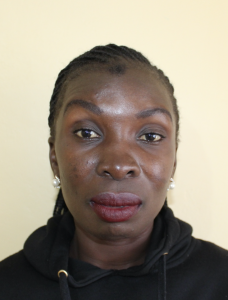June, 2020: COVID-19 Prevention Training Update at Mubinga Community, Mulutondo Spring
Our teams are working on the frontlines of the COVID-19 pandemic. Join us in our fight against the virus while maintaining access to clean, reliable water.

Trainer Christine hands out informational pamphlets on COVID-19
We are carrying out awareness and prevention trainings on the virus in every community we serve. Very often, our teams are the first (and only) to bring news and information of the virus to rural communities like Mubinga, Kenya.
We trained more than 18 people on the symptoms, transmission routes, and prevention of COVID-19. Due to public gathering concerns, we worked with trusted community leaders to gather a select group of community members who would then relay the information learned to the rest of their family and friends.

Trainer Jacky leads homemade mask tutorial
We covered essential hygiene lessons:
- Demonstrations on how to build a simple handwashing station
- Proper handwashing technique
- The importance of using soap and clean water for handwashing
- Cleaning and disinfecting commonly touched surfaces including at the water point.

Explaining prevention reminders chart
We covered COVID-19-specific guidance in line with national and international standards:
- Information on the symptoms and transmission routes of COVID-19
- What social distancing is and how to practice it
- How to cough into an elbow
- Alternative ways to greet people without handshakes, fist bumps, etc.
- How to make and properly wear a facemask.

Handwashing demonstration
During training, we installed a new handwashing station with soap near the community’s water point, along with a sign with reminders of what we covered.
Due to the rampant spread of misinformation about COVID-19, we also dedicated time to a question and answer session to help debunk rumors about the disease and provide extra information where needed.

Christine demonstrates how to make a leaky tin
We continue to stay in touch with this community as the pandemic progresses. We want to ensure their water point remains functional and their community stays informed about the virus.

A community member practices the 10 handwashing steps
Water access, sanitation, and hygiene are at the crux of disease prevention. You can directly support our work on the frontlines of COVID-19 prevention in all of the communities we serve while maintaining their access to safe, clean, and reliable water.

March, 2020: Mubinga Community, Mulutondo Spring Project Complete!
Please note, all photos in this report were taken before social distancing recommendations went into place.
Mubinga Community now has access to clean water! Mulutondo Spring has been transformed into a flowing source of water thanks to your donation. We protected the spring, constructed 5 sanitation platforms for different households in the community, and we trained the community on improved sanitation and hygiene practices.

Women stand united at the spring
"As the Chair of this spring, I am very much pleased to have your organization reach us by helping us in this way. Our spring is now protected. Personally, I don't go to fetch water, but now I am happy because all of the community members including my own family will now have access to clean and safe water," said James Mudanya, who also serves as the community's pastor.

James Mudanya (left) with another community member celebrating the spring
Spring Protection
Community members provided all locally available construction materials, including bricks, wheelbarrows of clean sand, stones, and fencing poles. Accommodations and meals were provided for the artisan, and women and men lent their strength to the artisan to help with the manual labor, too.
The Process
First, the spring area was cleared and excavated to create space for setting the foundation of thick plastic tarp, wire mesh, and concrete. After the base had been set, both wing walls and the headwall were set in place using brickwork. The discharge pipe was fixed low in place through the headwall to direct the water from the reservoir to the drawing area.

Community members form an assembly line to pass concrete to the artisan working on the spring and stairs' foundation
As the wing walls and headwall were curing, the stairs were set and ceramic tiles were fixed directly below the discharge pipe. This protects the concrete from the erosive force of the falling water and beautifies the spring. The process of plastering the headwall and wing walls on both sides reinforces the brickwork and prevents water from the reservoir from seeping through the walls and allows pressure to build in the collection box to push water up through the discharge pipe.

Artisan cements and plasters the headwall
The source area was filled up with clean stones and sand and covered with a thick plastic tarp to prevent potential sources of contamination. Then soil was layered on top of the tarp so that community members could transplant grass to prevent erosion. Finally, the collection area was fenced in. It took about 2 weeks of patience for the concrete to dry.

Planting grass and working on the fencing over the spring box as clean water begins to flow
As soon as it was ready, people got the okay from our field officers to begin fetching clean water. We met them there to celebrate this momentous occasion. Happiness, thanksgiving, and appreciation were the order of the day flowing in all directions.

Boys pose with the newly protected spring
This community was so excited to see their spring protected. They said that before spring protection, they used to have a lot of wrangles among themselves and especially among women because of misunderstandings at the water point. For example, the water would become dirty after just one person fetching it, so the next person could not fetch it immediately afterward and would have to wait. Some people could not easily understand this and thought it was done deliberately. This has now changed since the discharge pipe has been put in place.

Working together at the spring during construction and having different people cooking for the artisans has brought them back together, community members said. Some neighbors would not even talk to each other before due to their long-standing disagreements at the spring, but now that is no more. The women especially felt that it was important to form a self-help group, popularly known as the chama so that if any of them have challenges, they can come together as one. Water has brought back the peace in this community, we were told.

Sanitation Platforms
All 5 sanitation platforms have been installed. These 5 families are happy about this milestone of having a private latrine of their own and are optimistic that people will no longer leave waste outdoors. We are continuing to encourage families to finish building walls and roofs over their new latrine floors.

A father and children stand with their new sanitation platform
New Knowledge
Community member Andika Malenya Muyande helped organize the training in coordination with our team. Together we found the community’s preferred date for training while considering other events in the community calendar such as the agricultural season and expected gatherings. When the day arrived, Facilitators Laura Alulu and Georgina Kamau deployed to the site.
20 people attended training, including local leaders from the community, and church. Though this was a good turnout, some of the key community members who helped facilitate this project were busy at a funeral in the neighborhood and were not able to attend, though they insisted others receive the training even in their absence. The weather of the day was sunny, making it so favorable for training purposes.

Volunteers demonstrate toothbrushing to the group
The venue - a water user's homestead - was also conducive for learning because people sat on chairs while a few sat down on the grass, and it was central to the attendees' homes. The level of participation and involvement differed. One participant was extremely active, the team recounted, as she could openly answer all questions. She would also shut down someone if they pretended to say something that they were not practicing back at home. The young children who were there also sat down quietly and listened.

Training participants mimic the 10 steps of handwashing
We covered several topics including community participation in the project; leadership and governance; personal and environmental hygiene; water handling and treatment; operation and maintenance of the spring and sanitation platforms; dental hygiene; the 10 steps of handwashing, and how to make and use a tippy tap and leaky tin. During the leadership and governance session, we held an election for the leaders of the newly formed water user committee.

The elected water user committee leaders stand proudly
We also brainstormed income-generating activities that can be used to start both a community savings account for any future minor repairs to the spring, as well as a cooperative lending group (a chama) to enable members to develop their own small businesses.
What made the personal and environmental hygiene sessions special were 2 things. First, as we walked around to check the homestead of the woman who was hosting the training, we found a homemade handwashing station outside her latrine. This was very good of her because it showed that good hand washing was practiced and she was able to serve proudly as an example to the group. Then, when training about handwashing, a six-year-old girl came in front to give a demonstration. She got most of the steps correct and was not afraid to show the rest of the participants. This was so amazing and it made the mature people feel so challenged. The girl was given several gifts both from the facilitator and other individuals who were touched by how she could do the demonstration so confidently and well.

Trainer Georgina pours water for the young volunteer demonstrating handwashing
When an issue arises concerning the water project, the water user committee is equipped with the necessary skills to rectify the problem and ensure the water point works appropriately. However, if the issue is beyond their capabilities, they can contact our team of field officers to assist them. In addition, we will continue to offer them unmatchable support as a part of our ongoing monitoring and maintenance program.

"I am glad today for the knowledge that I have acquired. I used to do most things wrongly, like how I used to store drinking water was not the correct way. I would do this because sometimes I don't get time but today I have been taught that I really don't need so much time, I just need discipline on how to practice hygiene. Now that I am the mother of the home, I have to make sure that my family understands what was trained since my husband and children were not present for the training," said Brenda Isimwa, who works as a local businessperson.
Thank you for making all of this possible!


 Protected Spring
Protected Spring
 Rehabilitation Project
Rehabilitation Project












































